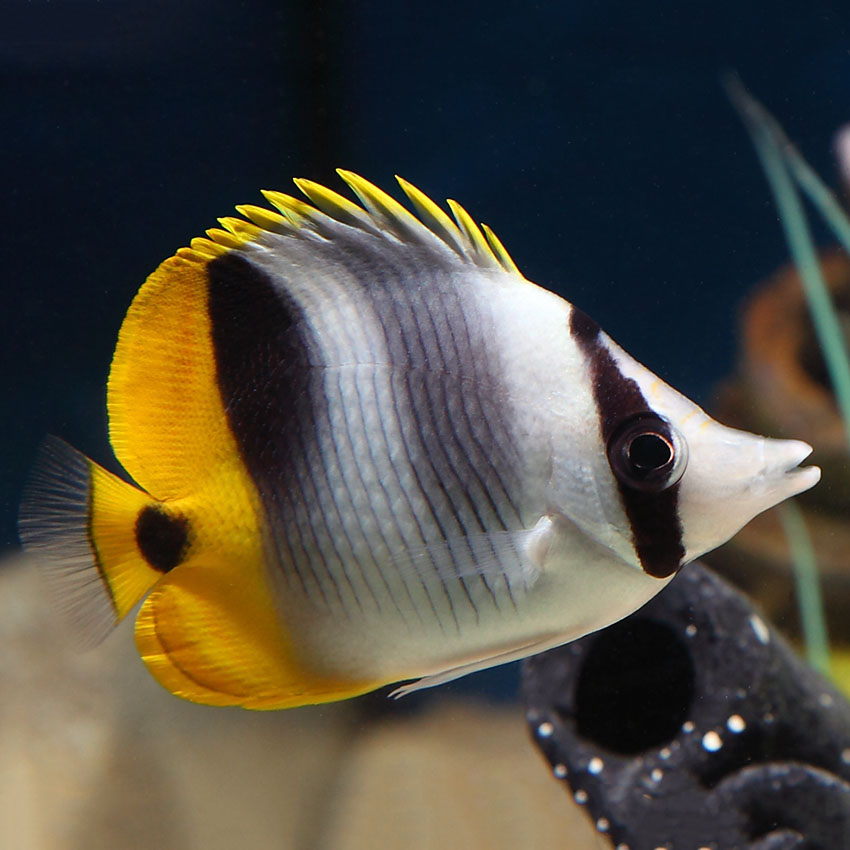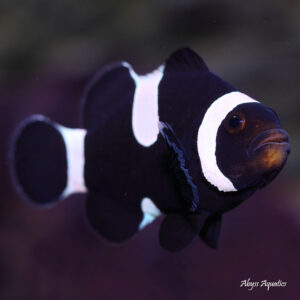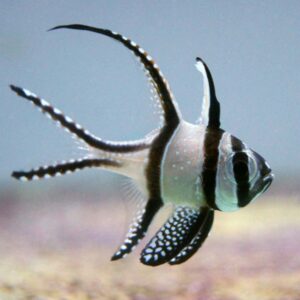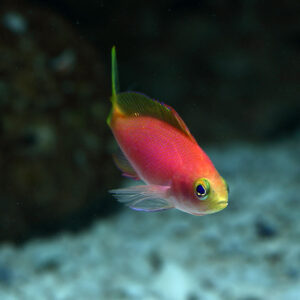The Double Saddle Butterfly Chaetodon ulietensis is a captivating reef fish that showcases a vibrant array of colours and distinctive markings. With a maximum size reaching up to 8 inches (20 cm) in length, this species boasts a compact yet striking appearance. Its body is adorned with a rich combination of yellow, white, and black hues, while two prominent black saddle-like patterns extend across its back, lending it its unique name.
Natural Habitat:
In its natural habitat, the Double Saddle Butterfly can be found inhabiting the serene and vibrant coral reefs of the Indo-Pacific region. These reefs are a haven for marine life, characterized by crystal-clear waters, diverse coral formations, and an abundance of food sources. Amidst the intricate coral structures, the Double Saddle Butterfly gracefully navigates, blending in seamlessly with its surroundings.
Keeping Double Saddle Butterfly Healthy: Moderate Care Level
The Double Saddle Butterfly requires moderate care and attention to thrive in a home aquarium. It is considered moderately difficult to keep due to its specific requirements. Providing stable water conditions with a temperature range of 75-82°F (24-28°C) and a pH level between 8.1 and 8.4 is crucial. Additionally, maintaining good water quality through regular filtration and monitoring ammonia, nitrate, and nitrite levels is essential for the health of this species.
Special Requirements and Feeding: Varied Diet for Optimal Health
To ensure the well-being of the Double Saddle Butterfly, it is important to offer a varied diet consisting of high-quality marine flakes, frozen or live brine shrimp, mysis shrimp, and finely chopped seafood. This species thrives on a mix of plant matter, small invertebrates, and meaty foods, mimicking its natural feeding habits. Regular feeding, typically two to three times a day, will promote optimal growth and vibrant coloration.
How Many Should I Keep?
Due to its territorial nature, it is recommended to keep a single Double Saddle Butterfly in a well-established aquarium. A tank with a minimum capacity of 50 gallons (190 litres) is suitable to accommodate this species comfortably. Attempting to keep multiple individuals may result in aggressive behaviour and territorial disputes, jeopardizing the well-being of the fish.
Lighting Preference: Simulating Natural Sunlight
Providing appropriate lighting is crucial for the overall health and well-being of the Double Saddle Butterfly. Mimicking natural sunlight conditions using full-spectrum reef lighting systems is ideal.
Suitable Tank Mates:
When selecting tank mates for the Double Saddle Butterfly, it is important to choose peaceful and compatible reef species. Suitable companions include other peaceful butterflyfish, angelfish, gobies, and smaller wrasses. It is advisable to introduce tank mates of similar size to prevent potential aggression or predation.
Reproduction in the Wild:
The reproductive behaviour of the Double Saddle Butterfly in the wild remains somewhat of a mystery. Like many other butterflyfish species, it is believed to engage in pair bonding, where a male and female form a monogamous relationship. They likely engage in intricate courtship rituals, followed by the release of eggs and subsequent fertilization in the water column.
Breeding Chaetodon ulietensis:
Breeding the Double Saddle Butterfly in captivity is a complex and challenging endeavour due to several factors. First, this species has specific reproductive requirements that need to be carefully replicated in an artificial setting. Additionally, the success rate of breeding this species is relatively low, and it often requires a dedicated and experienced aquarist.
- Set up
To initiate the breeding process, a separate breeding tank with appropriate conditions must be set up. This tank should have pristine water quality, stable parameters, and plenty of hiding spots for the fish to establish territories. The water temperature should be maintained between 78-82°F (25-28°C), and the lighting should mimic natural daylight.
- Courtship and Spawning
Introducing a compatible breeding pair is crucial for successful reproduction. It is best to introduce a bonded male and female that have already exhibited courtship behaviour. Providing rock or coral fragments can serve as potential spawning sites for the female to deposit her eggs. The male will then fertilize the eggs released by the female.
After the eggs are laid, it is essential to remove the parents from the breeding tank to prevent them from consuming the eggs. The eggs typically hatch within 24 to 48 hours, and the larvae will begin to swim freely in the water column. At this stage, it is crucial to provide an appropriate food source for the larvae, such as phytoplankton and rotifers, to ensure their survival and development.
- Rearing
Rearing the larvae can be challenging, as they have specific dietary and environmental requirements. They need frequent feedings of small, nutritious foods to support their growth. Regular monitoring of water parameters and ensuring optimal water quality is vital for their health.
Despite the difficulties, successfully breeding the Double Saddle Butterfly can be a rewarding achievement. It contributes to the conservation of the species and provides valuable insights into their reproductive biology and behaviour.
Sexual Dimorphism:
The Double Saddle Butterfly exhibits subtle sexual dimorphism, where the male and female have slight variations in appearance. In general, males tend to be slightly larger and have a more elongated dorsal fin compared to females. However, distinguishing between the sexes based on physical characteristics alone can be challenging, and more reliable methods, such as observing courtship behaviours, are often used to determine gender.
Distribution:
The Double Saddle Butterfly, Chaetodon ulietensis, is native to the Indo-Pacific region, specifically the waters around Indonesia, Papua New Guinea, and the Solomon Islands. These vibrant coral reef ecosystems are its natural habitat, where it can be found in abundance.
In the aquarium trade, there are instances where Double Saddle Butterfly specimens are referred to as captive bred or line bred strains. This indicates that these individuals are offspring of fish that were successfully bred and raised in captivity. However, it is important to note that the original fish used to establish these captive bred lines still originate from their native range in the Indo-Pacific.
Summary:
The Double Saddle Butterfly, Chaetodon ulietensis, is a captivating reef fish known for its vibrant colours and unique markings. With a maximum size of 8 inches (20 cm), it adds a striking presence to any aquarium. This species thrives in a well-maintained tank with stable water conditions, proper feeding, and suitable tank mates. Breeding the Double Saddle Butterfly is challenging, but it contributes to the conservation and understanding of this remarkable species. Whether observed in its natural habitat or admired in a carefully curated aquarium, the Double Saddle Butterfly never fails to captivate with its beauty and grace.
Dry Goods Delivery.
The store has provided information regarding their order dispatch and estimated delivery times. Here are the key details:
- Dispatch Timeframe: Orders placed before 2pm will be dispatched on the same day. Orders placed after 2pm will be dispatched on the next working day.
- Delivery Date and Time Guarantee: While the store aims to dispatch orders promptly, they cannot guarantee a specific delivery date and time. As the delivery process relies on couriers, there may be factors beyond their control that could affect the delivery timeframe.
- 1st Class Mail: For orders sent via 1st Class mail, the aim is to have them delivered on the next working day after dispatch.
- 2nd Class Mail: Orders sent via 2nd Class mail typically take approximately 2-3 working days for delivery after dispatch.
- APC Next Day Delivery: APC Next Day delivery is available for UK mainland postcodes. It is usually delivered on the next working day after dispatch. However, please note that items being delivered to more remote areas may require additional time for delivery.
It’s important to keep in mind that while the store strives to provide efficient delivery services, unforeseen circumstances or external factors could potentially impact delivery times. For further details or specific inquiries about delivery, customers should refer to the store’s terms and conditions or contact the store directly.
Livestock Delivery.
The store maintains specific policies regarding the delivery of livestock. Here are the key points:
- Licensed Livestock Courier: The store exclusively uses a licensed livestock courier for shipping fish and coral. This approach is chosen to ensure responsible and ethical transportation of the livestock.
- Livestock Shipping Fee: The livestock shipping fee charged to customers of £19.99 does not cover the true cost, and therefore, there is a minimum spend requirement of £30.00 before the option for livestock shipping becomes available.
- Pre-Arranged Delivery: The store never ships livestock without first arranging a suitable delivery day. Before dispatching the livestock, the store must confirm the agreed-upon delivery day with the customer.
- Saturday Delivery Confirmation: Customers who choose Saturday delivery must have their availability confirmed for the upcoming Saturday before the store sends out the livestock. This confirmation ensures that the livestock can be received promptly.
- Failure to wait for livestock: Not waiting for livestock, even if there is a reasonable delay, or cancelling an order after it has been dispatched will lead to you incurring charges for an emergency return to the base. Additionally, any losses of livestock will also be charged to you. Please be aware that the items you are ordering are living creatures – livestock. We kindly ask that you refrain from ordering livestock if you are unable to accommodate the possibility of a delayed delivery.
These terms and conditions are a fundamental aspect of our policy. Our primary goal is to dissuade individuals who could react negatively to a delayed delivery and subsequently request order cancellations. It is of utmost importance to underscore that your order pertains to living creatures, not mere inanimate objects. In the event of an occasional delay, it is crucial that you respond in a rational and responsible manner, taking into account the welfare of the livestock. We kindly request that you refrain from placing an order for livestock if you tend to react strongly to such situations. By proceeding with the order of livestock, you indicate your acceptance and agreement to abide by these specified terms and conditions.
- Signature Requirement: Livestock deliveries require a signature upon receipt and cannot be left in a safe location. This precaution ensures proper handling and the well-being of the livestock.
- Geographic Restrictions: The courier has strict geographic restrictions for livestock deliveries. Unfortunately, deliveries to Northern Ireland, Republic of Ireland, Isle of Man, Isles of Scilly, Channel Islands, and certain Scottish offshore postcodes may not be possible. Customers are encouraged to contact the store via email to confirm if livestock delivery is available in their area.
- Minimum Order Value and Order Cancellations: The store has a minimum order value of £30 for livestock shipping. Additionally, the store reserves the right to cancel orders that are deemed high-risk or involve a high number of single tropical freshwater fish species.
It is essential for customers to familiarize themselves with these policies before making a purchase. For more detailed information or specific inquiries, customers should consult the store’s terms and conditions or reach out to the store directly for clarification.
Livestock Geographical Exemptions.
The store has specific geographical exemptions for livestock deliveries. Here is a list of the areas and postcodes where livestock delivery is not available:
- Islands: Livestock cannot be delivered to the Shetlands, Channel Islands, and Isle of Man.
- Postcodes: Livestock delivery is not available to the following postcodes:
- AB30 to AB39, AB41 to AB45, AB51 to AB56
- DD8 to DD10
- BT all
- DG3 to DG9, DG12 to DG14
- KA18 to KA19, KA26, KA29 to KA30
- HS all
- IM all
- JE all
- ZE all
- KW15 to KW17
- TD9
- FK17 to FK21
- GY all
- KA26, to KA28
- PA20 to PA38, PA41 to PA49, PA60 to PA61, PA76 to PA78
- TR21, to TR25
- PH3 to PH26, PH30 to PH44
- IV all
Customers residing in these areas should be aware that livestock delivery is not available to their location.
We can ship livestock to the Isle of Wight, this area is subject to a surcharge.
For further information or specific inquiries about livestock delivery to a particular area, customers are advised to contact the store directly for clarification.
Cancellation.
According to the store’s policy, customers have the right to cancel an order within 14 working days of receiving the goods. To initiate the cancellation, the goods must be returned to the store in new and unused condition, adhering to their Returns Policy.
Important points regarding the return process are as follows:
- Return Condition: The goods must be returned in new and unused condition, as originally received. It is important to ensure that the goods are in the same condition as when they were sent out.
- Return Timeframe: The goods must be received by the store within 21 days of notifying them about the cancellation. During this time, customers are responsible for any loss or damage that may occur during the return shipping process.
- Refund Process: Once the store receives the goods in new and unused condition, they will initiate the refund process. The purchase price will be refunded to the customer.
- Return Condition Inspection: If the returned goods arrive in a condition that is less than what they were sent out in, the store reserves the right to return the goods to the customer, and no refund will be processed.
It is essential for customers to carefully review the store’s Returns Policy and follow the specified procedures to ensure a smooth and successful return and refund process. For more detailed information or specific inquiries, customers should consult the store’s terms and conditions or contact the store directly.
Returns.
According to the store’s return policy, the following guidelines should be followed for returning goods:
- Use Returns Form: Customers need to use the store’s provided returns form to initiate the return process. This form helps the store acknowledge that the goods are being sent back.
- Return for Testing: If the goods are being returned for testing, the customer is responsible for covering the return shipping expenses.
- Refund of Postage Fees: The store will only refund postage fees if the order arrives damaged or becomes faulty within the first 4 weeks of purchase. Proof of posting is important, and customers should ensure the goods are well-packed and obtain proof of posting as the goods remain their responsibility until received by the store.
- Refund of Postage Costs for Replacement: If goods are being returned within 7 days of purchase under the Replacement Policy, the store can refund postage costs. However, the customer needs to agree on a delivery service with the store in advance, and only standard or tracked shipping fees will be refunded. The store cannot refund the cost of any special delivery service.
- Non-Refundable Postage: Postage costs for goods returned for any other reason than those mentioned above are non-refundable. The store reserves the right to deduct the original postage cost from any applicable refund.
- Mistaken Purchases: If a customer has made a mistake in their purchase, they need to return the goods to the store. The customer is responsible for the return shipping costs in such cases.
It is important for customers to carefully follow the store’s return procedures and terms and conditions. For further details or specific inquiries, customers should refer to the store’s website or contact the store directly.
Replacements
If customers receive faulty goods, the following guidelines apply according to the store’s policy:
- Notification of Faulty Goods: Customers must notify the store within 7 working days if they receive faulty goods. This notification should be made as soon as possible.
- Replacement Parts: If possible, the store will dispatch replacement parts for the faulty goods.
- Return of Goods: If replacement parts are not possible, the store may request customers to return the faulty goods in accordance with their Returns Policy. The specific return procedures and conditions should be followed.
- Verification of Damage: Once the store receives the returned goods, they will verify the damage. If the damage is confirmed, the store will supply the required replacements.
- Return Postage Costs: If the goods returned to the store are found to be in good working order, the store is not able to refund the return postage costs. Additionally, the store reserves the right to deduct their original postage cost from any applicable refund.
- Consequential Loss or Damage: The store cannot take responsibility for any consequential loss or damage that arises directly or indirectly from the goods supplied.
Customers should carefully review and adhere to the store’s Returns Policy and procedures for returning faulty goods. For further clarification or specific inquiries, customers should consult the store’s terms and conditions or contact the store directly.
Manufacturer’s Guarantees
The store works in collaboration with manufacturers to ensure that their guarantees are honored, and they make their best efforts to resolve issues within the warranty period. The following guidelines apply to refunds and replacements:
- Postage Costs under Manufacturer’s Guarantee: Postage costs can only be refunded if the goods are returned to the store within 7 days of the original purchase, as per the manufacturer’s guarantee.
- Refund of Postage Costs for Faulty Goods: The store will refund postage costs for guarantee/warranty returns only if the product becomes faulty within the first 4 weeks of receipt.
- Replacements with Manufacturer Authorization: Replacements, whether parts or goods, can only be offered when authorized by the manufacturer. Customers should contact the store for further guidance in such cases.
- Prior Approval for Returns: Goods should not be returned to the store without prior approval. Customers need to contact the store and obtain approval before returning any items.
- Replacement of Glass or Ceramic Items: Glass or ceramic items can only be replaced if the store is notified within 48 hours of receiving the delivery.
- Replacement of Glass Bulbs/Tubes: Glass bulbs or tubes can only be replaced if they become faulty within 14 days.
Customers should note and adhere to these guidelines to ensure a smooth and efficient resolution of any issues with their purchased items. For specific inquiries or further information, customers are advised to refer to the store’s terms and conditions or contact the store directly.
Breakages
According to the store’s policy, customers have the following responsibilities regarding breakages:
- Checking Goods on Arrival: It is the customer’s responsibility to thoroughly check the goods upon arrival for any damage. This should be done before signing for the parcel. If the parcel appears damaged, it is advised not to sign for it.
- Reporting Breakages: Any breakages or damages must be reported to the store within 48 hours of receiving the goods. It is important to promptly notify the store to initiate the resolution process.
By carefully inspecting the goods upon arrival and reporting any breakages within the specified timeframe, customers can ensure that appropriate actions are taken to address the issue. For specific instructions on reporting breakages or further information, customers should refer to the store’s terms and conditions or contact the store directly.





Reviews
There are no reviews yet.